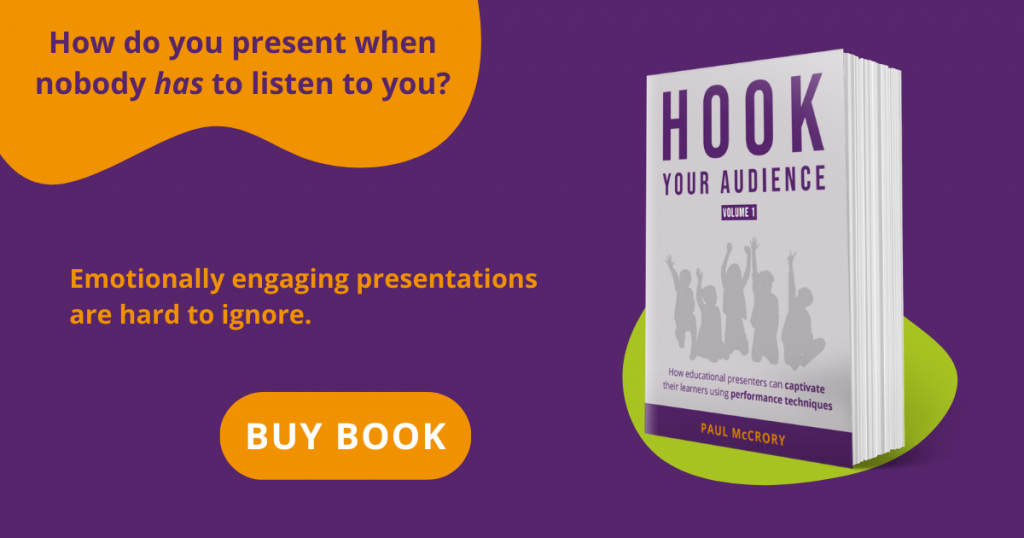Hook Your Audience - summary
Paul McCrory Updated 29/11/21
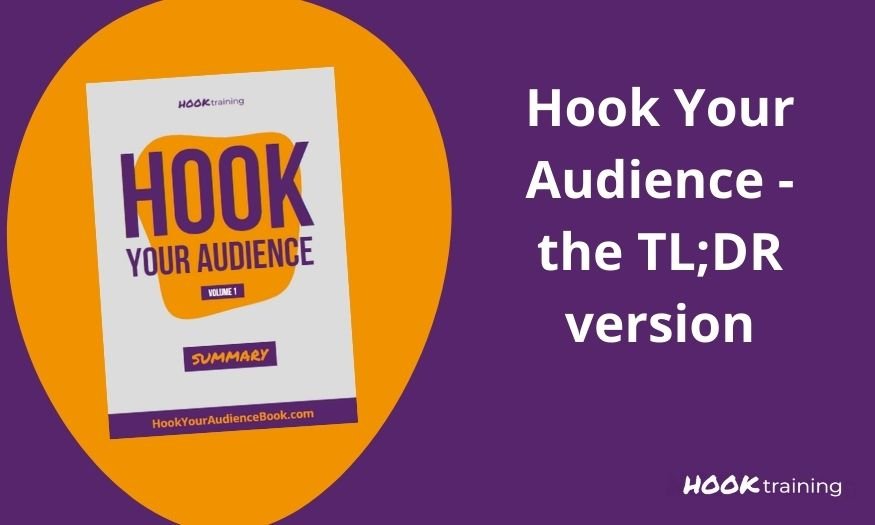
Hook Your Audience is a toolkit of performance techniques to engage child and family audiences in interactive, educational presentations. This article compiles the end-of-chapter summaries from the book in one place to allow educators to quickly get an overview of some of the key ideas in each tool. You can also download it as a handy PDF to keep.
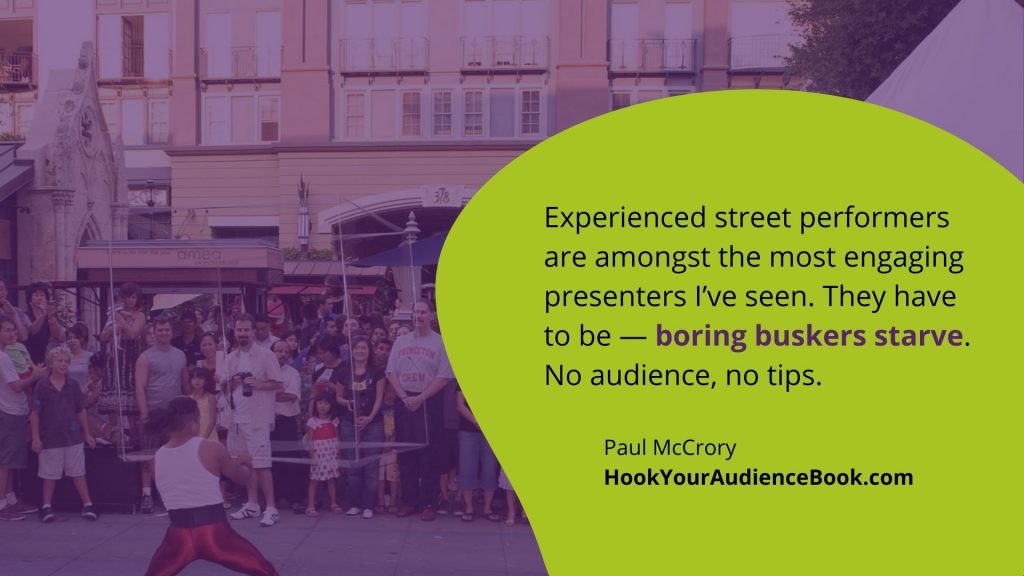
Hook their attention
- In informal education, nobody has to listen to you. Voluntary audiences often have physical and mental freedom and will only listen if they find you interesting. Without being able to win and hold their attention, you can't achieve any of your other objectives.
- Your outcomes can be diverse and hard to measure. They can include both short and long-term gains, e.g. changes in emotional response, interest, understanding and skills, motivation, self-efficacy, attitudes and behaviour.
- Most informal educators aim to provoke emotional responses and interest as vital first steps towards other learning outcomes later. The conditions under which most informal education takes place limit the breadth and depth of content that can realistically be explained.
- We think our audience is paying much more attention than they actually are because we are so passionate about our subject. Their brains are incredibly powerful in filtering out stimuli that aren't either immediately interesting to them or directly relevant to their survival.
- A hook is any stimulus that provokes the involuntary attention of all your learners. The better you understand the universal (situational) interests of your audience, the more effectively you can choose your hooks. These should be deployed throughout the presentation, not just at the beginning.
- Emotions are a powerful source of hooks. Any time you elicit an emotional response you will grab the attention of all of your audience (e.g. curiosity, amusement, anticipation, happiness, wonder, surprise, joy of understanding or mild fear).
- Internal hooks come from the overlap between the universal interests of the audience and the topic you are presenting.
- External hooks can be used to supplement internal hooks. These are added from outside the topic, in the hope that learners attend long enough to discover interest within the subject.
- You are a performer. Informal educators share many of the key challenges in engaging voluntary audiences that other performers do, e.g. magicians, stand-ups, street performers, actors and children's entertainers. The engagement hooks toolkit borrows techniques from these fields and applies them to our role.
- Interactive presentations should aim to find the optimum balance between being responsive and being deliberate. In this way, the audience feel as if they can interact with and influence the presentation, yet the thought you have put into every element allows you to guide them towards the most satisfying experience.
- Listen to the room. Trust the audience to be your directors by guiding you through their verbal responses and body language, but don't over-react to individual cues.
- Know your audience. Since relevance is such an important element of a hook, the more you know about your audience — or can reasonably assume — the better you will be able to engage them.
- Facing the honesty of voluntary audiences, especially children, helps to hone your engagement skills. You can then use these hard-won skills to hook any audience, voluntary or captive.
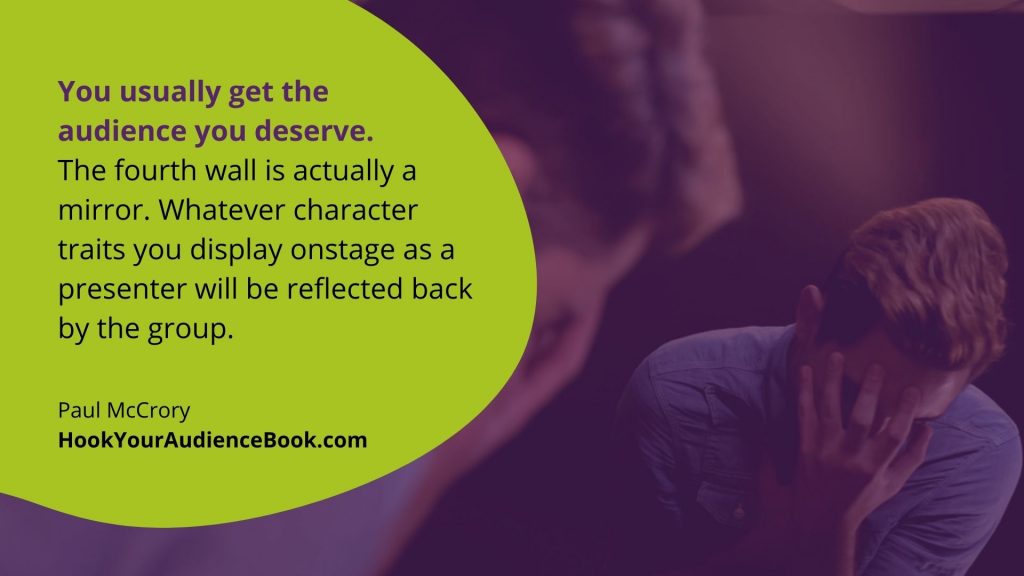
Connect through your character
- Your presenting character is how you connect as a human being with the other human beings in front of you. It includes your personality traits; your attitude to your audience and your content; and your individual worldview and values.
- Character is the most powerful engagement tool in the toolkit. Much of the power of the other tools comes from how they shine a spotlight on your persona for the audience. So, it's safer to use the techniques in this tool intentionally once you've developed your self-awareness and had experience with many different kinds of audiences.
- Connect as a person before you communicate as an educator. This is particularly true when your audience doesn't have to listen. Our effectiveness as informal educators depends much more on their perception of our human qualities than many of us dare to imagine.
- The audiences you work with are initially more interested in you, than in anything you do or say, unless you happen to be doing something extremely engaging. Learn how you can exploit this social aspect of human nature to connect your audiences with your beloved material through you.
- Imagining you are excitedly sharing an idea you care about with your friends is the best way to clarify your character as a novice educator. Don't overthink it, but be a bigger version of this person onstage.
- For more experienced educators, express your character by carefully editing and exaggerating. Select the “best version of you” from your complex and multi-faceted personality for that audience and role; without adding any extra traits. And then carefully exaggerate these qualities so they project from the stage.
- The more you exhibit behaviours involving participation, play, pressure and power, the more the audience believe they are getting to see the "real" you. These exposure behaviours, however, can just as easily reveal your character flaws as they can highlight your strengths.
- When working with voluntary audiences, you need to be likeable. Show that you like them; be physically expressive; open up to them; demonstrate fairness; reveal your sense of humour; and, occasionally, lower your status.
- Be human. Your learners need to see part of themselves in you. When they can relate to you, they are more likely to find what you present to be relevant and interesting, e.g. declare your struggles with a topic.
- Build your trust bank with the audience early and monitor it during the presentation. In any interactive presentation, trust is your hidden human currency. Unless you can make your learners feel physically and psychologically safe, they won’t risk interacting with you.
- Your audience want to have confidence in you, so you need to demonstrate authority as a presenter. However, few things reveal character as clearly as your restraint in how you exercise your considerable power.
- Blend authority and vulnerability. Presentation vulnerability is about becoming more open and responsive. Human beings find it impossible to ignore someone being vulnerable. The more open you are, the more your learners will reciprocate by revealing themselves.
- Character development never ends. It's a tool which presenters re-visit and work on continually. Learning to express the most engaging version of yourself truthfully in the spotlight is the work of a lifetime.
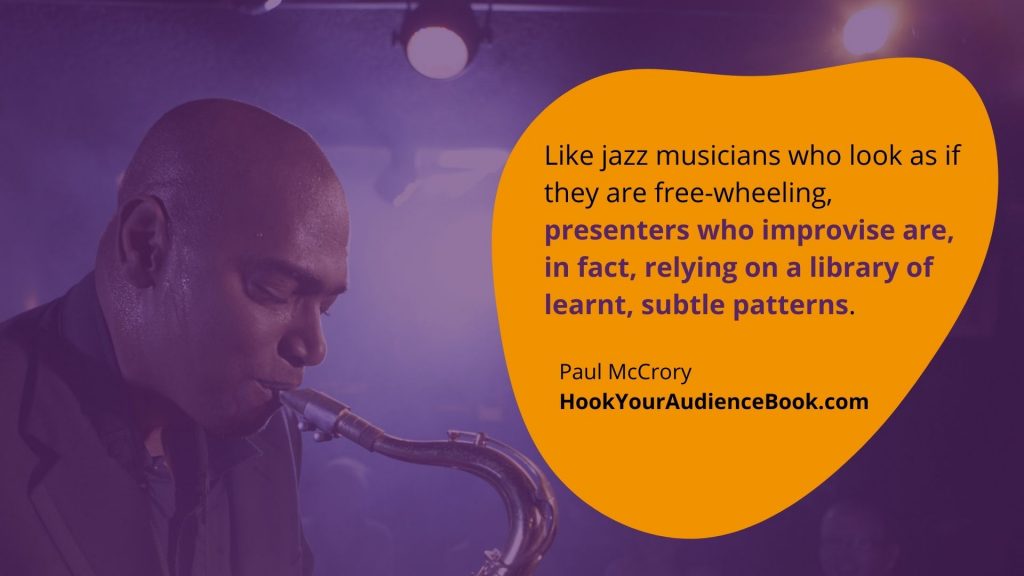
Embrace the liveness
- Make as much of your content as possible appear that it is improvised using the illusion of spontaneity. Audiences crave live, responsive experiences. But, they also care about being satisfied by their overall journey through the presentation. The way around this conundrum is to deliver prepared material in such a way that it looks spontaneous.
- Adopt the rivers and lakes model for your interactive presentations. Your routines are made up of tightly scripted paths ("rivers"), where the audience have little influence, and looser, interactive sections where they appear to have more control ("lakes"). These responsive phases are themselves made up of subroutines — smaller, self-contained units which are each carefully crafted.
- Each of your lines or actions falls into one of four levels of spontaneity, along the spontaneity spectrum. The levels are:
— fixed content (delivered in more-or-less the same way each time); — engineered content (prepared elements which look as if they have been prompted by the audience or the environment, but which you elicit);
— recalled content (crafted responses to the various unexpected incidents that recur in live presentations); and
— improvised content (truly spontaneous replies, made in the moment). - Fixed, engineered and recalled content uses a form of interactive scripting, so you can communicate in the most concise, clear and compelling way in every delivery.
- Your delivery will be dominated by fixed and engineered content, with only sprinklings of recalled and improvised content when the circumstances allow. All of these types of content should be blended together so naturally that the audience can't see the joins.
- Every delivery should have the freshness of the first performance. Even though much of our presentations are necessarily formed of fixed content, we need to create the illusion of the first time for the sake of our audience.
- Backleading is where you secretly guide the audience towards a particular call out or action, so that you can deploy a planned subroutine in response. But, done skilfully, it will feel to the audience as if they are in control.
- Much of your engineered content comes from figuring out how to make your happy accidents happen on demand. A happy accident is any incident in which an unexpected event leads to a recovery that is so strong, the routine becomes more impactful with the accident included.
- Incorporation is instantly adapting an engineered or recalled bit in small ways so that it feels grounded in what is happening onstage and in the audience at that moment.
- Prepare a library of recalled content which you can use in response to the most common unexpected incidents. You can then plan how to take advantage of these engaging situations when they arise.
- Improvisation is about being fully present so you can react spontaneously and honestly to whatever happens around you. It is a performance muscle that requires constant practice.
- Re-incorporation, or call backs, are where you refer back to an earlier line or situation in the presentation. These references can be planned or spontaneous. Call backs help to bond an audience by creating a shared experience and they find them amusing and satisfying.
- Audiences never worry about occasional mistakes as much as you. They will only get uncomfortable when you visibly get uncomfortable. Rather than hiding them, some mistakes are moments of peak attention to be exploited — your response to a problem reveals the version of you they will trust the most.
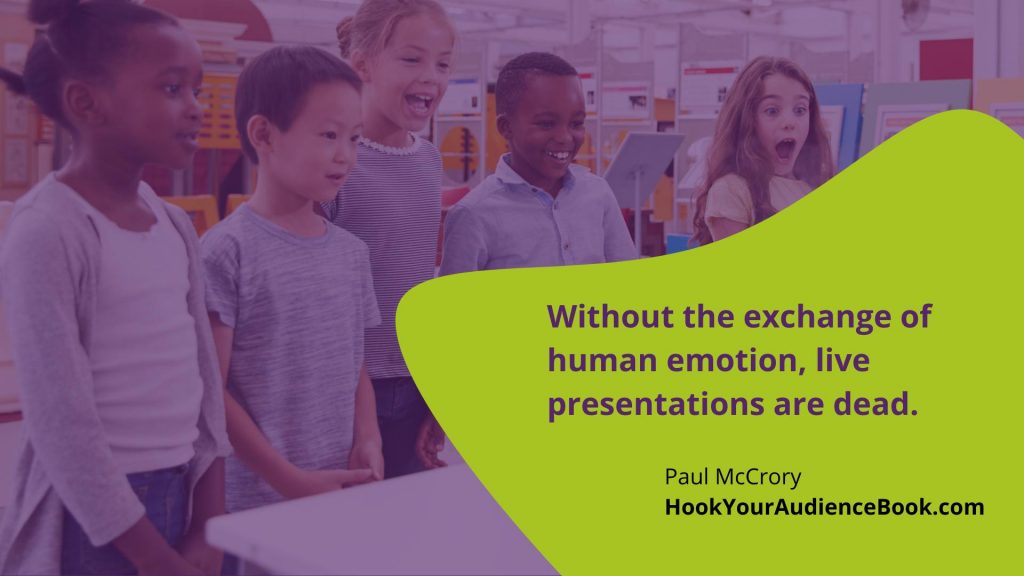
Express your emotions
- A zombie presenter is someone who unwittingly exhibits an emotional disconnection with their audience. There are multiple causes of this common presentation condition.
- Enthusiastic presenters are watchable because they display a rich range of emotions, e.g. joy, amusement, curiosity, wonder, puzzlement, surprise, amazement, awe, excitement, fascination, anticipation, uncertainty, relief, triumph, pride, disappointment, confusion, embarrassment, hope, shock, disgust, anger, indignation, fear, frustration, jealousy, worry, sadness, panic and boredom.
- The most engaging presenters vary the intensity of how they express their emotions — across mild, moderate, strong and extreme levels. It is the variation in the intensity of a feeling which is more interesting for the audience than constantly working at the peaks.
- You need to infect the audience with your emotions. By using nonverbal communication to model your emotions clearly, you can cause the audience to pick up these feelings themselves. This powerful effect is known as emotional contagion and it is the secret to emotionally engaging any audience.
- The inexperienced zombie — when you begin presenting there are several powerful psychological effects that make you much less expressive than you think you are. The best approach, at this stage, is to follow a two-step strategy — relax sufficiently so that your emotions can emerge naturally; and then amplify those raw emotions.
- As a novice presenter, it's alright to feel as if you are being sickeningly enthusiastic — that's not how you will come across to your audience. How you express your emotions always needs to fit your character and your learners, but it should still feel uncomfortable when you start learning how to project your emotions onstage.
- The formal zombie — some educators can adopt a shield of formality when presenting in order to protect themselves in the spotlight. Stop hiding. Embrace the vulnerability and jeopardy of your situation. This is what makes you watchable.
- The uninterested zombie — sometimes, as an informal educator, you'll be required to give presentations about topics in which you initially have little interest. At these times, you'll need to develop a range of strategies to either find or borrow interest so that you can maintain your enthusiasm.
- The jaded zombie — to be able to express convincing emotions when delivering the same presentation repeatedly, you need to find efficient ways of recreating how you first felt when doing that presentation. You are not being duplicitous. This is an unavoidable consequence of your job.
- The distracted zombie — challenges in our personal and work life can cause us to lose mental focus and struggle to express our emotions properly onstage. During these periods, you need strategies which allow you to compartmentalise as much as possible and concentrate on the presentation you are giving.
- The burnt-out zombie — emoting, on demand, in each presentation can be exhausting to sustain day after day. In order to avoid burning out, it's important to protect your emotional and physical health; take presenting breaks; talk to colleagues; watch out for the warning signs; and seek support.
- The over-enthusiastic zombie — occasionally, some presenters can become so expressive that this also creates a disconnection with their learners. The point at which your physical animation becomes too much depends on your character and your audience.

Interact through play
- More than anything else, audiences love interacting spontaneously with you. They find the feeling of co-creating a unique experience for that presentation exhilarating. This is the magic of live performance.
- Interact with the adults as well as the younger spectators. You need to give the grown-ups permission to contribute and confidence that you will not embarrass them if they do respond. Also, the adults who attend your programmes will find the behaviour of their children extremely watchable.
- Being playful is one of the quickest ways to connect with learners of all ages, especially when they don't have to listen. Play is also the universal language of children. Many of the characteristics of play — enjoyable, voluntary, safe, empowering, creative — are essential ingredients of effective informal learning experiences.
- Imbue your presentation with lots of potential games for the audience to play with you. Children adore uncovering these bits of business based on interaction. Discovering and playing these games gives them an empowering sense of spontaneity and co-creation.
- Cocoon your audience and stage in a play bubble where people feel safe to play. This space is fragile and precious, so protect it fiercely. Let one unkind or judgemental remark from the crowd go unchallenged and the bubble will burst.
- Empower them by rolling over occasionally during these games. Children grow up in a world where adults seem to know everything and they know nothing. By deliberately inhibiting your advantages as the presenter, they, for once, get to feel as if they are in control or that they know something an adult doesn't. This sensation is irresistible to a child.
- Audience interaction turns up the spotlight on the other engagement tools. It magnifies the impact of your character, the liveness of the situation, the emotional contagion in the audience, and the opportunities for situational humour. But its glare cruelly exposes your flaws, as clearly as it amplifies your strengths, so monitor your interactions for any negative traits they may be leaking.
- Train your audience how you want them to interact. You can't expect your learners to know how to contribute unless you guide them. The more effort you put into this training at the start, the richer and more rewarding all their interactions will be for the rest of the presentation.
- Develop a play bow that nonverbally signals to the audience when you are inviting them to play. For example, exhibiting — spontaneity; high energy; warm eye contact; delight; smiling and laughing; momentarily lowering your status; being mischievous; repeating behaviour patterns.
- Start with a warm-up routine. This is particularly important with young audiences, as it gets them all responding expressively and energetically together.
- Be patient with audiences who are slow to respond initially. You can only present interactively with their co-operation. Don’t overpower your group with interaction techniques which require them to take big risks too soon. Instead, gradually build your trust bank.
- Children find unexpected failures from an adult, funny and empowering. When using this presenter-in-trouble hook, the more mature your audience, the more convincing you need to be in how you mess up.
- One of the most addictive interaction games you can play with any group of younger children is "look, but don't see". This multi-phase game allows them to spot your mistake or an impending peril some time before you appear to realise the problem.
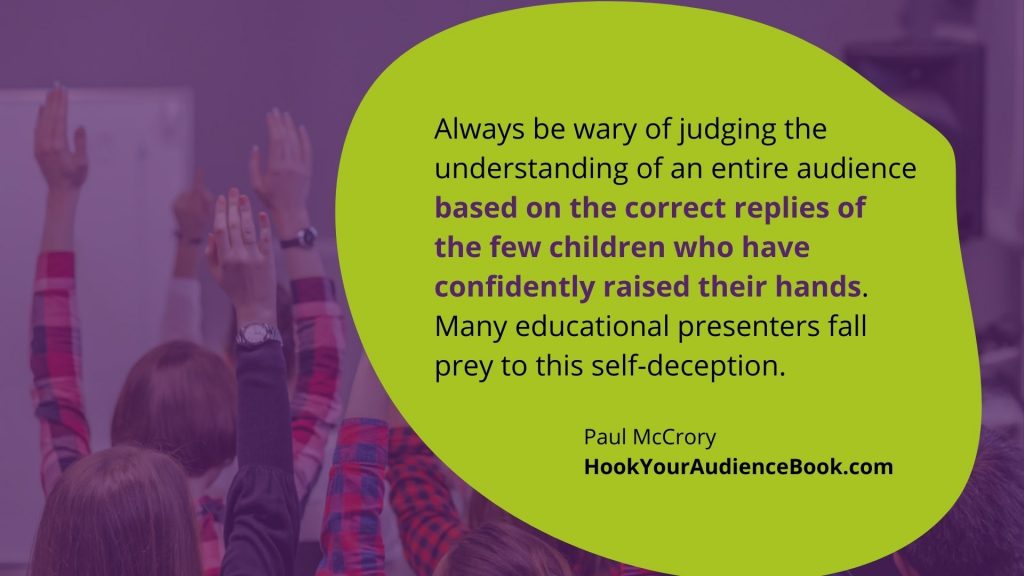
Exploit questions
- Questions to and from the audience are a key part of interactive presentations. But asking questions, dealing with responses and answering their questions all take considerable management when working with children. Also, you need to be even more sensitive with an individual than you do when interacting with the whole audience.
- Ask questions strategically. Managing questions is time-consuming, so you need to plan and deploy them wisely at the best times. Hone your precise phrasing over time to reduce any misunderstandings.
- Use a variety of question types. Most questions in a large-group presentation will be closed with short, factual answers, but try to mix these up with occasional open-ended enquiries.
- Pose one question at a time. Sometimes, when we're trying to catch up in a presentation, we merge questions or we don't leave a long enough wait time for a response before the next one.
- Vary your use of a "hands up" policy depending on the age of the audience and the phase of the presentation. The interactive approach recommended in this toolkit requires most audiences to have the freedom to make elicited responses and spontaneous call outs.
- Be scrupulously fair in how you select learners to answer or ask questions. Make sure that you are seen to choose from across as wide a range of characteristics as possible, e.g. age, gender, race, ability.
- Show that you care about their questions and their answers. Saying something in front of everyone is probably a big thing for them, so listen carefully to what they say and be respectful of their contribution.
- Praise their answers warmly, but in an age-appropriate way. The younger the child, the more overt and emphatic you can be. Older children can resent being singled out for acclaim.
- Deal with incorrect answers sensitively. This will soften any disappointment or embarrassment they might feel. But the older the audience and the more they trust you, the more robust you can afford to be in your corrections.
- Learn how to turn the question tap on and off. It's possible to take questions during the presentation for most ages, but you need to constantly adjust the flow rate of these questions so they don't take over.
- You don't have to answer every question you are asked, e.g. you might defer a question because you're going to come on to this issue later or because it is too specialised to answer during the presentation.
- Answer as clearly and concisely as possible. Unfortunately, clarity and brevity are usually only possible with a prepared response from your bank of commonly-asked questions. Answering a question in front of an audience for the first time is high risk.
- Never bluff it when you don't know the answer. If you're worried that your reply might involve dangerous over-simplifications which could damage their future learning, it's better not to attempt a response. Modelling how to deal honestly and confidently with ignorance could be the single most valuable lesson your presentation imparts.
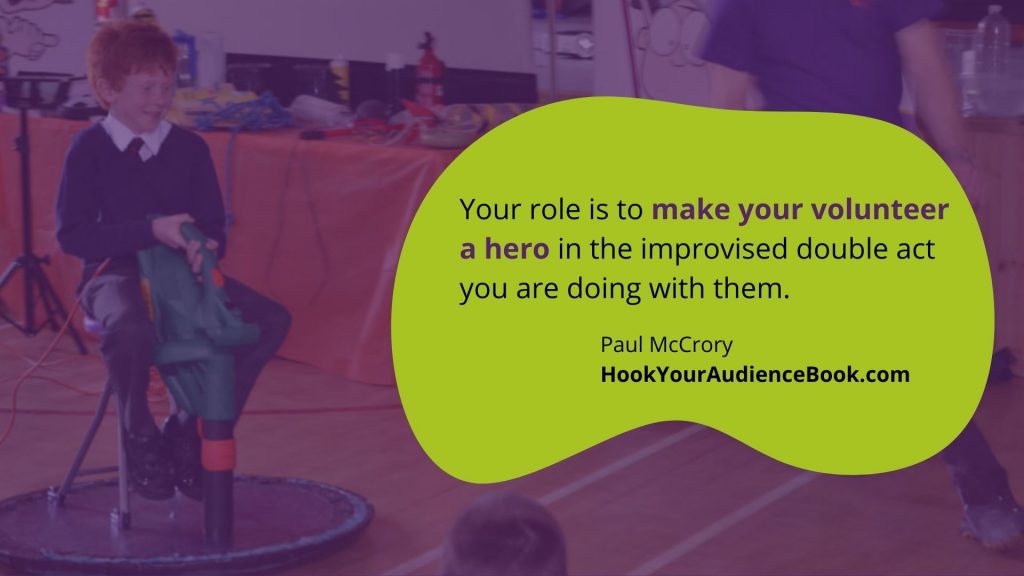
Make your volunteers heroes
- Using volunteers is one of the most popular elements of interactive presentations in informal education. This tool, however, is a double-edged sword, as it also carries risks.
- The audience believe the way you treat their representative on stage is how you also feel about each of them. So, whilst bonding well with your helper immediately connects you to all of the crowd, mistreating them in any way will destroy that connection just as quickly.
- You must be seen to choose help fairly across every demographic you can imagine. You can use a combination of public and private criteria to guide your selection towards volunteers who are expressive, co-operative and capable; and, ideally, who are likeable, relate well to you and give you just enough attitude to play off.
- Individual spectators are continually sending you lots of clues about how good a volunteer they might make. You need to learn how to notice and remember these signals at the same time as delivering your presentation.
- With reluctant groups, convince yourself that the first person you ask to help will comply without dissent. Your voice and body need to communicate absolute confidence, without showing any tension or doubt.
- Welcome your volunteers onstage warmly as if they are guests to your professional home. The quicker you can get them to relax, the more expressive, authentic and watchable they will become.
- Ask for their name when they arrive onstage and use it naturally throughout the routine. This helps to put them at their ease, demonstrates your friendliness and gives you more precise control. Be careful to pronounce their name correctly.
- Always protect the physical and emotional safety of your volunteers. They can feel nervous and vulnerable in this unfamiliar setting. This makes them more likely to be clumsy or to make mistakes; and it also makes them acutely sensitive to any negative audience reactions.
- Your role is to make your volunteer a hero in the improvised double act you are doing with them. Give them room to shine. Encourage them to contribute. Nurture how they express their personality. Ensure that they succeed at any activities you ask them to do.
- Work hard to hone your instructions so that they are as clear, yet as concise, as possible. It's hard for you to truly appreciate how confusing a task may seem to a volunteer in the spotlight.
- Children love when you place adults they care about in apparent jeopardy as a volunteer. The risk to the teacher or parent can be to their physical being, their property or their dignity. No matter how bad the developing situation may look, however, it is essential that the adult trusts that you are not going to actually harm or humiliate them.
- Train the audience to applaud every volunteer equally as they return to their seat. Join in this applause in a sincere way. This makes everyone feel good and shows your appreciation for how much they have added to the presentation.

Relate through humour
- Humour is a powerful engagement tool, but try to embed your content in the humour. The more you can align your humour with your message, the more powerful it becomes educationally.
- Humour, like a clown, has big feet. There’s a danger, if you use humour hooks too frequently, too strongly, or in the wrong places, that they will stomp all over your educational content. Smiles have smaller feet, but can be just as useful to you as laughs.
- Make them laugh when they're not expecting it. As an informal educator, nobody expects you to be funny. Exploit this assumption by using covert humour to extract most of your smiles and laughs naturally from the action onstage and your interactions with the audience.
- Supplement this safe humour with higher-risk overt humour, if this suits you. Getting an audience to laugh reliably when they know you're trying to be funny takes hard work, experience and aptitude. Some types of overt humour are easier to deliver than others, though, e.g. using funny images and videos created by other people.
- Learn to recognise a bad laugh. The benefits of using humour as an educator are wiped out when it is perceived as being hurtful, excluding or offensive. Paradoxically, however, this doesn't mean that your comedy should be bland — the closer you get to the edge, the funnier you usually are.
- You don't have to be naturally funny to use covert humour. It depends on principles which are so easy to exploit, it almost feels like cheating, e.g. letting them be funny; being fast; being authentic; surprising them; creating a pattern; exaggerating; revealing a shared experience; being subversive; and failing publicly.
- Landing a recognisably funny line or joke depends critically on your timing. You can only uncover the best timing for a specific joke by delivering it repeatedly in front of real audiences. Timing is an extremely subtle and dynamic variable.
- Most jokes follow a well-known structure — setting-up an assumption; reinforcing it; and then twisting this expectation. The best gags have a wording and delivery that is specific, concise and precise; with a twist that is brutal, postdictable and climatic.
- Commit fully to the line. If you hold back, even fractionally, from landing a funny line with your normal conviction, the audience response can suffer drastically. They can detect something is not quite right.
- When you bomb, keep calm and carry on. Bombing is an inevitable part of using overt humour. The main risk here is that your visible discomfort will infect the audience. If you can, through sheer force of will, appear unconcerned, they will hardly notice it.
If you've found this summary helpful and you would like to show your appreciation, please feel free to buy me a metaphorical hot chocolate.
No marshmallows, thanks. 🙂
Paul McCrory is an author, trainer and coach, based in the UK. He runs HOOK training, which helps informal educators to engage their learners using interactive performing skills and psychology.
Paul McCrory
HOOK training

